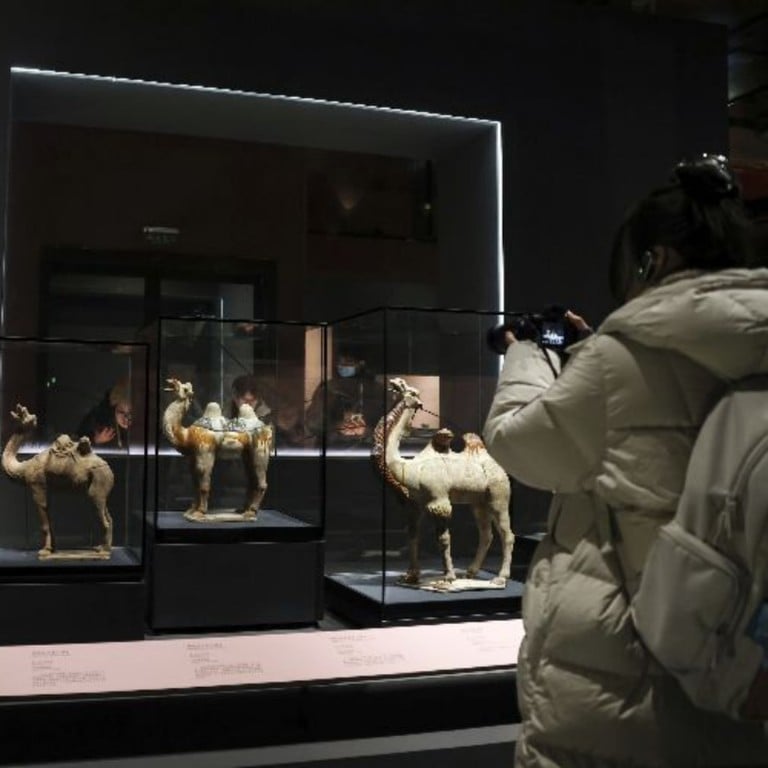
China-brokered Iran-Saudi peace dividend brings rare exhibits to Palace Museum
- Global South’s growing willingness to organise exhibitions outside Western influence on display at Beijing shows, according to observers
- Many of the ancient relics highlighting intertwined histories of Islam and ancient China cannot be displayed in the West because of US sanctions
The GCI was expected to open up new prospects for “enhanced exchanges and understanding” as well as “better interactions and integration of diversified cultures”, according to an official statement last year. “Together we can make the garden of world civilisations colourful and vibrant.”
From Al-Ula’s sandstone altars to Persian ceramics carved with Quranic patterns, the exhibitions examine the intertwined histories of Islam and ancient China through the exchange of goods and cultures along the Silk Road.
How China’s Saudi-Iran deal shows Beijing’s Mideast influence
Many of the relics cannot be displayed elsewhere because of extensive sanctions imposed by Washington on the two countries, which last year signed a historic peace deal in Beijing.
The agreement – reached between China, Iran and Saudi Arabia in March 2023 – ended a seven-year feud between the Middle Eastern neighbours, after Beijing called Tehran and Riyadh to the diplomatic table to achieve a reconciliation.
William Figueroa, an assistant professor of history and international relations at the University of Groningen in the Netherlands, said the exhibition serves to boost China’s “modern ties” with the Middle East, particularly Iran, and bears “tremendous educational value”.
“Such cultural and educational exchanges are an important part of China’s diplomatic strategy in the region, and are typically quicker and simpler to organise than the more complex business and trade arrangements,” he said.
Figueroa, who specialises in China’s interactions with Middle Eastern countries, said cultural exchanges could expand, deepening bilateral cooperation against the hits that Sino-Iranian economic relations had taken because of US sanctions.
“Plucking the relatively low-hanging fruit of cultural and educational exchange helps foster a sense of ongoing cooperation, which can facilitate more complex economic and diplomatic agreements,” he said.
How Xi Jinping promotes culture-Marxism mix to further ‘Chinese dream’
Tings Chak, art director at Tricontinental: Institute for Social Research, said the exhibitions were part of a “bigger historical process” of people in the Global South becoming culturally confident in their roots.
“As we see a new world order emerge, with the rise of the Global South and multilateralism, we are also beginning to see the decentring of Western civilisation as a hegemonic frame of reference,” she said.
“We cannot underestimate the importance of the Global South organising and touring exhibitions about our own histories and civilisations, rather than mediating them through old colonial capitals like London, Paris and New York, whose museums are filled with stolen artefacts from the formerly colonised world.”
Chak, who researches third world literary and cultural history at Tsinghua University, said many countries have demanded the repatriation of artefacts and noted Beijing’s recent request to the British Museum for the return of 23,000 Chinese cultural relics.
“I think it’s interesting that … Xi put forth the Global Civilisation Initiative (GCI) last year to complement the more economic and security-oriented … Global Development and Global Security Initiatives. This exhibition seems like a fruit of that effort.”
Chak noted that culture has played a role in China’s diplomatic outreach since the early days of the People’s Republic, when China “suffered heavily from US-led Western sanctions”.
“Arts and culture became a key way to establish friendship and relations with other nations and peoples – from dance and acrobatic troupes, to visits of writers and journalists, to holding exhibitions,” she said.
These exchanges were “an important avenue to build solidarity and friendship” between developing countries that were fighting for their own liberation and sovereignty, Chak added.
Visitors interviewed at the Iranian and Saudi exhibitions said they found them up to the standards of the Palace Museum and good for children, though some wished the number of exhibits could be increased.
A Beijing-based visitor who works in the media industry said she felt that Iran and Saudi Arabia had attached “great importance” to the exhibitions, with the former employing advanced multimedia technology in their section, while the latter focused on the range of its artefacts.
“I believe Saudi Arabia values this exhibition a lot given the rich content and presentation it offered, including large LED screens and advanced mock-up models, whereas for Iran, while its curation is more simplistic, the relics are magnificent,” she said.
Mansour Bai Ye, an Arabic teacher at the Beijing Language and Culture University, said that overall it was a good exhibition, “despite a few minor imperfections”.
“There are not many similar exhibitions in China, so this could be helpful to people seeking to understand the region’s ancient history,” he said.
The Shanghai Museum will host Egypt’s largest overseas exhibition of its artefacts for a month from July 19. More than 95 per cent of the 800 ancient exhibits featured are being shown in Asia for the first time.


